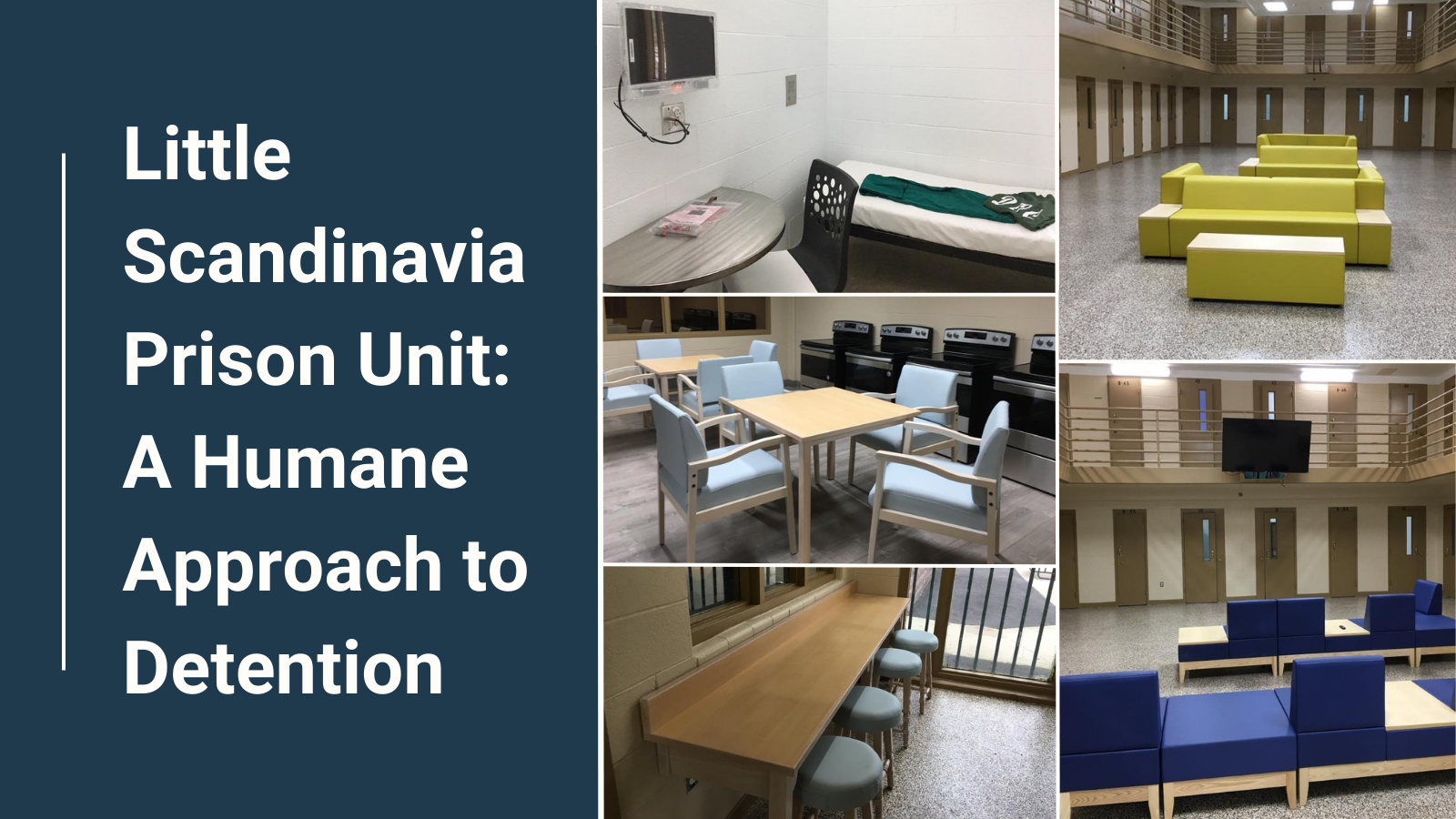Imagine a prison where the people who are incarcerated are “residents” who live communally in single cells with desks and small refrigerators and have access to a shared kitchen. Welcome to State Correctional Institution (SCI) Chester’s Little Scandinavia Prison Unit, an innovative program at a medium-security prison outside Philadelphia, Pennsylvania. The Unit is modeled after prisons in Scandinavia, where the core values are safety, transparency, and innovation, with a focus on normality and reintegration into the community upon release.
A Peaceful Prison
The Unit is the result of a multiyear partnership with the Norwegian Correctional Service, the Swedish Prison and Probation Service, and the Danish Prison and Probation Service. In 2019, Pennsylvania Department of Corrections employees traveled to Norway, Sweden, and Denmark to see for themselves how Scandinavian countries approach incarceration. Criminologists from the United States and Norway continue to follow the project, which opened at SCI Chester in May 2022, gathering data to assess the outcomes of a radically holistic carceral approach.
The Unit can house 64 men, with 55 currently living there. The environment is quiet, with residents living in single-person cells with a shared kitchen, surrounded by outdoor green space and plants. Residents go to work, treatment, and school within the SCI Chester system and then return home to their own cells in a quiet environment.
Residents are chosen through a lottery system, open to most of the 1,100 men in the SCI Chester system. The Unit is intended to reflect the general prison population, including individuals with mental health and behavioral health needs. Furthermore, the unit is not an “honor block” used to reward well-behaved individuals. There are no exclusions based on crimes or convictions. However, those with misconduct and violence in their recent past are excluded from the lottery.
The first six men chosen to live on the Unit are serving life sentences at SCI Chester and act as “mentors.” They moved to the Unit before the opening, working with staff to develop policies and procedures. Mentors have individual roles within the Unit, helping to mediate conflicts between residents and acting as a bridge between the residents and staff.
SCI Chester Superintendent Gina Clark oversees the Unit and firmly believes that the goal of corrections is to help people leave prison better than they were when they entered because, “we simply don’t want more victims.” Superintendent Clark observed that many of the Correctional Officers (called Contact Officers in the Norwegian system) felt pushback from others who may believe that we should punish people in prison, not make them comfortable.
“But for me, from day one as an officer, I decided to treat people with kindness, be fair, be true to the Department’s rules, and stay that way,” Clark says. “And if this unit keeps a person from offending again, why not try it?”
A Hybrid Job for “Contact Officers”
In the Scandinavian model, officers are “a hybrid of a corrections officer and corrections counselor,” according to Clark. They focus on reentry planning by working with residents on things like finances, employment, and education and knowing where to access programs and treatment. Contact Officers get to know the residents, sharing meals and giving advice. If there are problems or conflicts on the Unit, the residents and officers sit together and talk things out.
Although it is too early for conclusive data, Superintendent Clark has a sense that things are working. “When you talk to the men who live there, their attitudes have already changed. There’s more time to sit with your thoughts. They’re more focused and not worried about sharing a small space with another.” Staff members note that these interpersonal dynamics are quite meaningful in the context of their work. Researchers are exploring the role of the Contact Officer and want to understand a Contact Officer’s most effective role: is it to count heads and maintain security, or can they play a more integrated, involved part in the prison community?
Residents and staff resolve smaller conflicts involving, for example, the use of the one laundry facility or the kitchen. The SCI system handles any misconduct that violates prison policy, like contraband, drugs, or violence. According to researchers, serious misconduct seems to be down on the Unit and Superintendent Clark notes there have been no violent incidents to date.
The Jury Is Still Out
Funding from Arnold Ventures and others allows a robust collaboration between Jordan Hyatt, JD, PhD, of Drexel University and Synøve N. Andersen, PhD, of the University of Oslo, to evaluate the model’s effectiveness. The qualitative and quantitative data they are collecting are designed to focus on the lived experience of the people in the Unit, both residents and staff. Although it is too early to state outcomes definitively, Dr. Hyatt notes that “people on the Unit report higher levels of satisfaction with the community, especially regarding the relationships between the people who live and work there.”
Data focuses on prison climate, staff, disciplinary actions, and the well-being of the people serving their sentences, as well as the staff. A prison climate survey went out to all SCI Chester residents prior to opening the Unit, and then researchers surveyed residents who lived in the Unit. Overall, the researchers hope to capture data around reintegration back into the community, the effect on staff working in the Unit, and the comparative impact of the negative conditions of traditional confinement. While tracking recidivism is important, both Drs. Hyatt and Andersen also want to track outcomes related to the environment where men suffer less stress and conflict while incarcerated.
According to Andersen, there are “unintended consequences of prison on people, their families, and their health,” and perhaps a change in environment can potentially reduce some of this collateral psychological and physical damage.
One major factor in the potential success of the Unit is the stark contrast between American and Norwegian cultures and values around incarceration and criminal punishment.[1] These values translate to differences in the number of people incarcerated and correctional staffing requirements between the two countries. The United States has the largest population of incarcerated individuals of any country in the world. Meanwhile, Norway, a much smaller country, has relatively low incarceration rates. Norway’s prison population rate (the number of people incarcerated for every 100,000 people in the population) is 15, compared to the United States’ 629. Further, correctional officers in Norway must have at least a 2-year college-level education. While requirements vary from state to state, federal-level candidates in the United States need 9 hours of graduate study or 1 year of specialized experience.
Both Drs. Hyatt and Andersen state that a critical goal for them personally and professionally is to kick-start a conversation around what punishment needs to look like to serve our society and communities holistically. The project’s initial phase is 2 years, with May 2023 marking year 1. A Swedish public broadcaster will air a documentary on Little Scandinavia in April 2023. For more information, contact the research team at LittleScandinavia@drexel.edu.
[1] Jordan M. Hyatt, Synøve N. Andersen, and Steven L. Chanenson, “Prison cells as a grounded embodiment of penal ideologies: A Norwegian-American comparison,” in The Prison Cell: Embodied and Everyday Spaces of Incarceration, eds. Jennifer Turner, Victoria Knight (Cham, Switzerland: Palgrave Macmillan, 2020), 45-70.
Like what you’ve read? Sign up to receive the monthly GAINS eNews!


